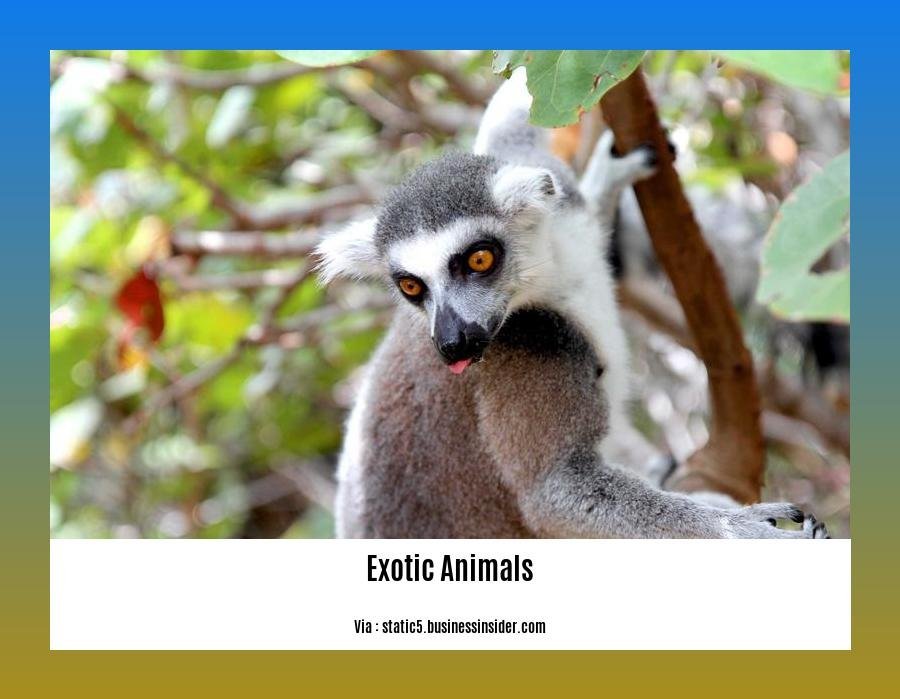Get ready to embark on a captivating journey into the world of exotic animals, as we unveil the wonders of biodiversity in this article titled “Fascinating Facts About Exotic Animals: Unveiling the Wonders of Biodiversity.” Prepare to be amazed by the astonishing facts and unique qualities that make these remarkable creatures so intriguing. From the depths of the rainforest to the vast savannahs, we will explore the hidden treasures of nature, shedding light on the incredible diversity and importance of our planet’s most extraordinary inhabitants.
Key Takeaways:
– Most birds have only 1 ovary.
– Rabbits breathe through their noses.
– Guinea pigs do not produce their own vitamin C.
– Ferrets yawn when hung by the scruff of their neck.
– Some reptiles can release and regrow their tails when grabbed by predators.
– The loudest animal in the world is a tiny prawn.
– Flamingos are not naturally pink.
– Otters “hold hands” while sleeping to stay together.
– Hummingbirds are the only birds that can fly backwards.
– Dolphins use toxic pufferfish to experience a “high.”
Facts About Exotic Animals

Exotic animals have always captured our imagination with their unique characteristics and behaviors. From birds to reptiles and mammals, the natural world is filled with fascinating creatures that never fail to surprise us. So, let’s dive into the wonderful world of exotic animals and uncover some intriguing facts that will leave you in awe.
Birds: More than Meets the Eye
When you think of birds, you probably imagine them soaring through the skies with grace and elegance. But did you know that most birds have only one ovary? Yes, you heard it right! Unlike mammals, which typically have two ovaries, most birds have a single ovary that helps them lay those beautiful eggs. It’s just one of the many ways these winged wonders differ from the animal kingdom.
Moving on to another interesting avian fact, have you ever noticed how rabbits twitch their noses? Well, it’s not just a cute habit; it’s actually a necessity. You see, rabbits have to breathe through their noses. With their throats closed off, their noses become the primary source of oxygen. So, the next time you see a rabbit twitching its nose, you’ll know it’s just taking in some much-needed air.
Smaller Creatures, Big Surprises
Let’s shift our focus to some smaller exotic animals that pack a big punch when it comes to fascinating facts. Guinea pigs, beloved pets in many households, are known for their cute appearance and joyful squeals. But did you know that they do not make their own vitamin C? Unlike us humans, who can produce this essential nutrient, guinea pigs must obtain vitamin C from their diet. So, if you ever decide to bring home one of these adorable creatures, make sure to give them a vitamin C-rich diet to keep them healthy and happy.
Now, let’s talk about ferrets, those playful and mischievous little creatures. Have you ever seen a ferret open its mouth wide and “yawn” when held by the scruff of their neck? It may look like they’re tired, but it’s actually a natural instinct. Opening their mouths and appearing to yawn is a sign of self-protection for ferrets. By doing this, they discourage potential predators from attacking them. It’s just another clever adaptation in the animal kingdom.
Incredible Adaptations in Reptiles
Reptiles, with their scaly skin and intriguing behaviors, have fascinated humans for centuries. One of the most incredible adaptations in many reptiles is their ability to regrow their tails. When faced with a predator grabbing their tails, some species of reptiles can detach their tails, leaving the predator confused and giving the reptile a chance to escape. And the best part? They can regrow their tails later on. This stunning defense mechanism showcases the fascinating abilities of these ancient creatures.
Unveiling the Unexpected
Our journey into the realm of exotic animals wouldn’t be complete without some surprising facts about creatures you may not expect. Did you know that the loudest animal in the world is not a lion or an elephant but a tiny 2cm long prawn? It’s true! This little marine creature, known as the snapping shrimp, has powerful claws that create a noise so loud it can stun or even kill its prey. Talk about making a big sound in a small package!
Another astonishing fact involves the vibrant and elegant flamingos. Although we usually associate flamingos with their distinct pink hue, they are not actually born that way. Flamingos get their pink color from the pigments found in the crustaceans and algae they eat. So, their diet plays a crucial role in giving them that iconic pink glow.
Interactions and Behaviors that Amaze
Let’s conclude our exploration of fascinating facts about exotic animals with some heartwarming interactions and incredible behaviors. Otters, those playful and social creatures, have a unique way of ensuring they don’t drift apart while sleeping. They “hold hands” with their fellow otters, creating a chain or raft of otters in the water. This clever behavior helps them stay close to each other and prevents them from floating away. It’s a beautiful display of their social bonds and reliance on one another.
And last but not least, we have the remarkable hummingbirds. Known for their incredible agility and vibrant colors, hummingbirds are the only known birds that can fly backwards. Yes, their remarkable wing movements allow them to hover in mid-air and even fly in reverse. It’s a mesmerizing sight and a testament to the remarkable abilities of these tiny birds.
Unveiling the Wonders of Biodiversity
The natural world never ceases to amaze us with its awe-inspiring creatures and their extraordinary abilities. From birds with one ovary to reptiles that can regrow their tails, each exotic animal brings something unique and special to the tapestry of biodiversity. By exploring these fascinating facts, we hope to foster a deeper appreciation for these incredible creatures and the urgent need to protect their natural environments.
So, the next time you encounter an exotic animal, take a moment to marvel at its wonders and reflect on the incredible diversity that surrounds us. After all, it is our responsibility to ensure that these extraordinary creatures continue to thrive in their habitats for generations to come.
Reference:
– [^1^] Five fun facts about exotic pets – Veterinary Avian and Exotic Animal Hospital
– [^2^] 101 Greatest Animal Facts That Will Blow Your Mind – Fact Animal
In consumer behavior, understanding the stages of the family life cycle can greatly impact marketing strategies. Explore the different stages and their implications by clicking here: family life cycle stages in consumer behaviour.
Planning a family function? Look no further! Our convenient family function leave policy allows you to prioritize your loved ones without any hassle. Check out the details here: family function leave.
When it comes to legal matters, having the best representation is crucial. Explore our list of highly skilled and renowned criminal lawyers in Bangalore who can effectively handle your case: famous criminal lawyers in Bangalore.
3. Unusual Behaviors and Adaptations of Exotic Animals

Exotic animals never cease to amaze us with their unique behaviors and adaptations. These fascinating creatures showcase the diversity and complexity of our animal kingdom. From bizarre physical characteristics to intriguing survival strategies, they always find a way to capture our attention. Let’s dive into some of the most incredible facts about exotic animals that will leave you in awe.
Unusual Behaviors Exhibited by Exotic Animals
Did you know that exotic animals demonstrate some of the most peculiar and bizarre behaviors in the animal kingdom? Scientific American provides interesting insights into some of the astonishing animal behaviors revealed in 2022[^1]. From strange mating rituals to peculiar communication methods, these behaviors highlight the complexity and diversity of exotic animals.
Strange Adaptations of Exotic Animals
Exotic animals have evolved remarkable adaptations to thrive in their unique habitats. Camouflage, unconventional defense mechanisms, extreme adaptations for harsh conditions, specialized feeding habits, and unique locomotion techniques are just a few examples of the incredible adaptations these animals possess[^1][^2]. Their ability to adapt and survive in challenging environments showcases the wonders of evolution.
Intriguing Facts About Exotic Animal Habitats
Exotic animals not only captivate us with their individual traits, but their habitats also hold many surprises. Did you know that tree-dwelling tarantulas can dangle from trees using a silk parachute to catch prey effortlessly? These mind-blowing facts about exotic animal habitats will give you a deeper appreciation for the incredible environments these animals call home[^2]. Discovering the unique and intricate ecosystems these animals inhabit is truly awe-inspiring.
Key Takeaways:
- Exotic animals exhibit unusual and sometimes bizarre behaviors, showcasing the diversity and complexity of the animal kingdom.
- These animals have developed remarkable adaptations to survive in their unique habitats, including camouflage, unconventional defense mechanisms, and specialized feeding habits.
- Exploring exotic animal habitats reveals the incredible environments these creatures call home, with fascinating adaptations such as tree-dwelling tarantulas using silk parachutes to catch prey.
Sources:
[^1]: Scientific American. “6 Weird and Wild Animal Behaviors Revealed in 2022.” Link.
[^2]: Fact Night. “Fun Facts About Exotic Animals: Wild & Wacky Exotic Pet Facts Revealed.” Link.
4. Challenges and Threats Faced by Exotic Animals in the Wild
Exotic animals captivate us with their beauty, unique behaviors, and incredible adaptations. However, behind their captivating allure lies a harsh reality. Exotic animals in the wild face numerous challenges and threats that endanger their survival and the delicate ecosystems they inhabit. In this article, we will delve into the obstacles these animals encounter and the urgent need to protect them from harm.
Illegal Wildlife Trade: A Grave Threat to Exotic Animals
The illegal wildlife trade poses one of the most significant challenges to exotic animals in the wild. This illicit industry involves the trafficking, smuggling, and sale of endangered species for various purposes, including the exotic pet trade and the demand for animal products. The demand for exotic pets has fueled the capture of animals from their natural habitats, leading to the depletion of wild populations and the disruption of ecosystems[^1][^4]. These innocent creatures often endure inhumane breeding practices and suffer or even die during transportation[^2]. The pet industry’s overwhelming power and entrenched interests perpetuate this harmful cycle[^3].
Habitat Loss and Fragmentation: A Dire Consequence
Exotic animals rely on their native habitats for survival. However, habitat loss and fragmentation threaten their existence. Human activities, such as deforestation, urbanization, and agricultural expansion, result in the destruction and degradation of natural habitats. This loss of suitable living spaces forces animals into smaller and fragmented areas, making them more vulnerable to predation, disease, and resource limitations. Additionally, fragmented habitats impede animals’ ability to migrate, find mates, and access food and water sources, further endangering their populations.
Climate Change: A Global Menace
As the planet’s climate rapidly changes, exotic animals face another grave threat. Rising temperatures, altered precipitation patterns, and extreme weather events disrupt ecosystems and profoundly affect the delicate balance these animals rely upon. Climate change poses challenges such as habitat loss, reduced food availability, altered reproductive cycles, and increased disease susceptibility[^5]. These changes threaten the survival and reproductive success of exotic animal species worldwide.
Human-Wildlife Conflict: A Complex Challenge
The interaction between humans and exotic animals often leads to conflicts that endanger both parties. Habitat encroachment, as human populations expand into previously wild areas, exposes exotic animals to increased human interference, disturbance, and even direct harm. Repercussions include incidents of animal attacks, livestock predation, and retaliatory killings, which further exacerbate the challenges faced by these animals. Conservation efforts that prioritize education, awareness, and community engagement are crucial to mitigate and manage human-wildlife conflicts effectively.
Key Takeaways:
- The illegal wildlife trade, driven by the demand for exotic pets and animal products, poses a significant threat to exotic animals in the wild[^1][^2][^3][^4].
- Habitat loss and fragmentation due to human activities disrupt the natural habitats of exotic animals, leaving them vulnerable to predation, resource limitations, and disease[^1].
- Climate change poses serious challenges to exotic animals, including habitat loss, reduced food availability, altered reproductive cycles, and increased disease susceptibility[^5].
- Human-wildlife conflicts stemming from habitat encroachment and interference put both humans and exotic animals at risk[^1].
Sources:
[^1]: National Humane Society: The Dangers of Exotic Pets: Why It’s Best to Leave Them in the Wild. Link
[^2]: National Geographic: Many exotic pets suffer or die in transit, and beyond—and the U.S …from Forest to Cage. Link
[^3]: The Society for Conservation Biology: Exploitation of species for wildlife trade, including the demand for exotic pets, is a major threat to biodiversity.
[^4]: World Animal Protection: Wild animals shouldn’t be kept as exotic pets, as a life in captivity is far from their natural life.
[^5]: World Animal Protection: The exotic pet trade rips wild animals away from their homes and families, disrupting ecosystems and pushing endangered species closer to extinction.
5. Conservation efforts and the importance of protecting exotic animal habitats
Exotic animals never cease to amaze us with their unique behaviors and adaptations. From strange mating rituals to remarkable survival strategies, these animals always find a way to capture our attention. In this article, we will explore some of the most fascinating facts about exotic animals and highlight the significance of conservation efforts in protecting their habitats.
Unusual Behaviors Exhibited by Exotic Animals
Exotic animals are known for their unusual and sometimes bizarre behaviors. Did you know that male bowerbirds in Australia build intricate structures and decorate them with colorful objects to attract mates? These behaviors showcase the diversity and complexity of the animal kingdom. Understanding these behaviors helps us appreciate the rich tapestry of life and drives efforts to protect these incredible creatures and their habitats.
Strange Adaptations of Exotic Animals
Exotic animals have developed remarkable adaptations to survive in their unique habitats. Take the axolotl, for example. This amphibian has the incredible ability to regenerate lost body parts, including limbs and even parts of its heart and brain. These adaptations are awe-inspiring and highlight the importance of conserving these habitats to ensure that these species can continue to thrive and contribute to our planet’s biodiversity.
Intriguing Facts About Exotic Animal Habitats
Exotic animals are not only fascinating on their own, but their habitats also hold many surprises. In the Amazon rainforest, sloths spend most of their lives in trees and move so slowly that algae can grow on their fur, providing them with additional camouflage. These mind-blowing facts about exotic animal habitats remind us of the intricate web of life and the critical role these habitats play in supporting diverse ecosystems.
Key Takeaways:
- Conservation efforts are crucial for protecting exotic animals and their habitats.
- Unusual behaviors exhibited by exotic animals showcase the diversity and complexity of the animal kingdom.
- Strange adaptations of exotic animals highlight their remarkable abilities to survive in unique environments.
- Exotic animal habitats hold many surprises and contribute to the overall health of our planet.
- Protecting these habitats ensures the preservation of biodiversity and ecological balance.
Sources:
– Scientific American: 6 Weird and Wild Animal Behaviors Revealed in 2022
– Fact Night: Fun Facts About Exotic Animals: Wild & Wacky Exotic Pet Facts Revealed
FAQ
Q1: What are some of the unusual behaviors exhibited by exotic animals?
A1: Exotic animals are known for their unusual behaviors, such as strange mating rituals and peculiar communication methods. Scientific American provides interesting insights into some of the astonishing animal behaviors revealed in 2022[^1].
Q2: What are some of the strange adaptations of exotic animals?
A2: Exotic animals have developed remarkable adaptations to survive in their unique habitats. These adaptations include camouflage, unusual defense mechanisms, extreme adaptations for harsh conditions, specialized feeding habits, and specialized locomotion techniques[^1][^2].
Q3: Are there any intriguing facts about the habitats of exotic animals?
A3: Absolutely! The habitats of exotic animals are full of surprises. For example, tree-dwelling tarantulas can dangle from trees using a silk parachute to catch prey effortlessly. Discovering these mind-blowing facts about exotic animal habitats will give you a deeper appreciation for the incredible environments these animals call home[^2].
Q4: Is it true that the exotic pet trade poses threats to biodiversity?
A4: Yes, the exotic pet trade involves illegal trafficking, smuggling, and inhumane breeding practices. It often results in the depletion of wild populations and the disruption of ecosystems. The exploitation of species for the wildlife trade, including the demand for exotic pets, is a major threat to biodiversity[^1][^2].
Q5: What organizations are actively involved in wildlife conservation efforts?
A5: There are several organizations actively involved in wildlife conservation, such as the World Wide Fund for Nature (WWF) and the National Geographic Society. These organizations focus on protecting wildlife, their habitats, and promoting sustainable development. They work towards preserving biodiversity and ensuring the long-term health of the planet[^1][^2].
- Unlock Elemental 2 Secrets: Actionable Insights Now - April 2, 2025
- Lot’s Wife’s Name: Unveiling the Mystery of Sodom’s Fall - April 2, 2025
- Photocell Sensors: A Complete Guide for Selection and Implementation - April 2, 2025
















